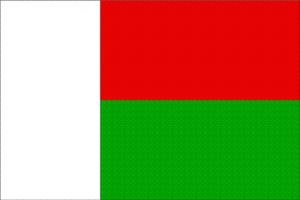Language/Plateau-malagasy/Grammar/Basic-Sentence-Structure
| ◀️ Alphabet and Pronunciation — Previous Lesson | Next Lesson — Basic Greetings ▶️ |
Introduction[edit | edit source]
Welcome to the "Complete 0 to A1 Plateau Malagasy Course"! In this lesson, we will delve into the basic sentence structure of the Plateau Malagasy language. Understanding the fundamental order of subjects, verbs, and objects is essential for constructing meaningful sentences. Throughout this lesson, we will explore various examples and explain the rules governing the Plateau Malagasy sentence structure. By the end of this lesson, you will be able to construct simple sentences in Plateau Malagasy with ease.
Subject-Verb-Object Order[edit | edit source]
In Plateau Malagasy, the basic sentence structure follows the subject-verb-object (SVO) order. This means that the subject of the sentence comes first, followed by the verb, and then the object. Let's break down each component and explore their roles within the sentence.
The Subject[edit | edit source]
The subject of a sentence in Plateau Malagasy is the entity or person performing the action. It is typically a noun or a pronoun. Here are a few examples:
| Plateau Malagasy | Pronunciation | English |
|---|---|---|
| Ankizy | [aŋˈkizʲ] | Children |
| Mpanao | [ˈmpanaw̥] | Teacher |
| Ianao | [ˈʲanaw̥] | You |
| Tompoko | [ˈtumˈpukʷ] | Sir/Madam |
The Verb[edit | edit source]
The verb in Plateau Malagasy expresses the action or state of being in the sentence. It is an essential component that conveys the meaning of the sentence. Here are a few examples:
| Plateau Malagasy | Pronunciation | English |
|---|---|---|
| Mandeha | [manˈdehə] | Go |
| Miresaka | [miˈresəkə] | Speak |
| Manao | [maˈnaw̥] | Do |
| Mankany | [manˈkanʲ] | Go to |
The Object[edit | edit source]
The object in Plateau Malagasy receives the action of the verb. It can be a noun, pronoun, or a phrase. Here are a few examples:
| Plateau Malagasy | Pronunciation | English |
|---|---|---|
| Fandefasana | [fanˈdefasənə] | Letter |
| Loha | [ˈluhə] | Rice |
| Ny tanàna | [nə tanˈanə] | The city |
| An-tanàna | [an tanˈanə] | To the city |
Simple Sentence Examples[edit | edit source]
Now that we understand the subject-verb-object order, let's see how it works in practice. Here are some simple sentence examples in Plateau Malagasy:
- Ankizy mandeha an-tanàna. (Children go to the city.)
- Mpanao miresaka ny teny malagasy. (The teacher speaks the Malagasy language.)
- Ianao manao asa. (You do work.)
- Tompoko mankany ny tanàna. (Sir/Madam goes to the city.)
As you can see, the subject-verb-object order remains consistent across different sentence structures. By following this order, you can construct grammatically correct sentences in Plateau Malagasy.
Cultural Insights[edit | edit source]
The Plateau Malagasy language is spoken primarily in the central highlands of Madagascar. While the subject-verb-object order is the standard sentence structure, it is worth noting that there may be regional variations in the usage or understanding of this order. Some dialects might have subtle differences, but the SVO order remains the foundation of Plateau Malagasy grammar.
Historically, the Plateau Malagasy language has been influenced by various cultural and linguistic factors. The Malagasy people are known for their rich oral traditions and storytelling. This cultural heritage has shaped the language and its grammar over time. Understanding the basic sentence structure allows learners to engage more deeply with the cultural nuances embedded within the Plateau Malagasy language.
Practice Exercises[edit | edit source]
Now it's time to put your knowledge into practice! Complete the following exercises to reinforce your understanding of the basic sentence structure in Plateau Malagasy.
Exercise 1: Constructing Sentences Using the words provided, create sentences following the subject-verb-object order.
- Words: Ankizy (Children), miresaka (speak), teny malagasy (the Malagasy language).
- Example: Ankizy miresaka teny malagasy. (Children speak the Malagasy language.)
1. Mpanao (Teacher), manao (do), asa (work). 2. Ianao (You), mandeha (go), an-tanàna (to the city). 3. Tompoko (Sir/Madam), mankany (go to), ny tanàna (the city).
Exercise 2: Translating Sentences Translate the following sentences from English to Plateau Malagasy, maintaining the subject-verb-object order.
- Example: The cat eats fish.
- Plateau Malagasy Translation: Ny sakafo mandeha fatatra.
1. The students study mathematics. 2. We love our family. 3. She buys a new car.
Solutions[edit | edit source]
Exercise 1: Constructing Sentences
1. Mpanao manao asa. (The teacher does work.) 2. Ianao mandeha an-tanàna. (You go to the city.) 3. Tompoko mankany ny tanàna. (Sir/Madam goes to the city.)
Exercise 2: Translating Sentences
1. Ny mpianatra mianatra ny matematika. 2. Izahay manao fitiavana ny fianakaviana. 3. Izy mividy fiara vaovao.
Congratulations on completing the exercises! You are making great progress in your journey to learn Plateau Malagasy.
Other Lessons[edit | edit source]
- Adjectives
- Conjunctions and Their Usage
- How to Use Be
- Conditional Mood
- Adverbs and Their Usage
- Descriptive Adjectives
- Present, Past, and Future Tenses
- Nouns and Gender
- Give your Opinion
- Alphabet and Pronunciation
Template:Plateau-malagasy-Page-Bottom
| ◀️ Alphabet and Pronunciation — Previous Lesson | Next Lesson — Basic Greetings ▶️ |

